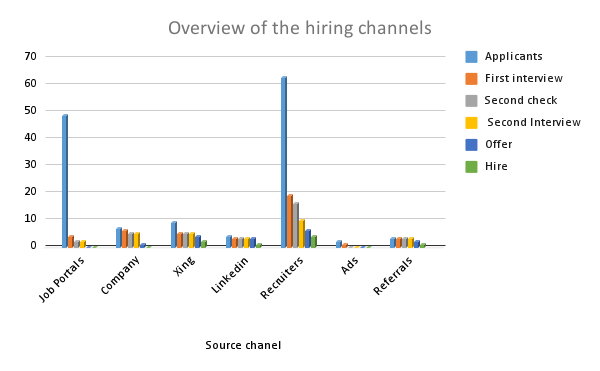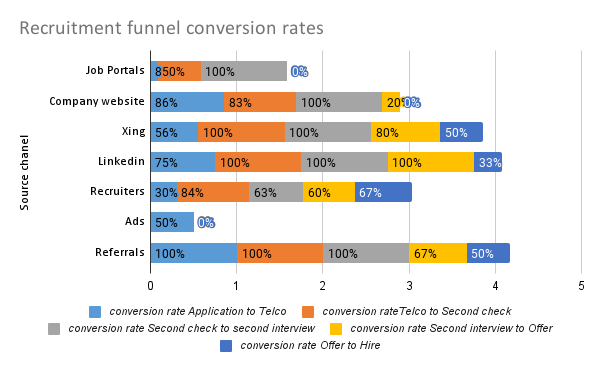
How People Analytics can improve recruitment?
( Top People Analytics use cases)
People Analytics can transform HR functions from recruitment and workforce strategic planning to performance management and employee engagement and retention. That means it can fully cover and support all the phases of an employee’s journey inside the organization with a data-driven approach.
In the continuation of the series “Top People Analytics use cases“, I will describe some of the roles of data and analytics in recruitment and selection in this article. You can read about the first use case ‘Employee Turnover Analytics’ in my previous article as well.
Recruitment Analytic
Finding the best people at the right time and for the appropriate positions is one of the most time-consuming and challenging tasks of human resource departments. Yet, employees are now the organization’s most critical assets and significantly affect its future success or failure. A comprehensive study by the Boston Consulting Group has shown that the recruitment function has the most notable impact on companies’ revenue growth and profit margins than any other human resources process.
So let’s see how People Analytics can facilitate the recruitment process in different stages.
From Descriptive Analytics to Diagnostic Analytics in Hiring and Recruitment
While finding and hiring the right people is the primary concern of most recruiters, understanding why not finding, attracting, and engaging those people is the other influential factor in improving recruitment. Analysing the process of engaging and attracting talents to join the organization is where People Analytics supports HR departments precisely with a data-driven approach and pushes them one step further to investigate the bottlenecks.
By gathering and analyzing data from each stage of the recruitment and moving from descriptive analytics towards diagnostic analytics, recruiters will uncover the reason behind the challenges in each state and optimize some of the most effective hiring metrics.
Using a data-driven approach in the recruitment process can save recruiters up to 23 hours of manual labour a week. They are reducing the amount of time taken to shortlist and pre-screen candidates.
A few key metrics
The analytics approach defines different metrics to track and analyze the process and performance based on the recruitment process. These metrics can focus on the strategies of hiring or afterwards on the quality of recruited employees. Here are the most popular and usable metrics in almost all the companies to track their recruitment process:
- Time to hire: The days between the candidate applying and accepting the job offer
- Cost to hire: The sum of all recruiting costs (internal and external) divided by the number of hires in a specific time.
- Quality of hire: The value a new hired employee adds to the company (can be defined based on her productivity, performance, tenure, or generally her life time value)
- Offer acceptance rate: The percentage of offers that are accepted.
- Selection ratio: The ratio of the candidates who are actually selected to all candidates.
- Conversion rate: The percentage of successful candidate who passed to the next stage of the recruitment funnel.
Mentioned metrics will provide good insights into the recruiting process to accommodate them in a data-driven approach. Since just calculating the metrics can not grant us a much more profound understanding, formulating them based on what we have done and expected to achieve is a good start. In this manner, improving the metrics will also standardize the processes for easier tracking and refinement.
Evaluating the best recruitment methods
One of the key sectors within the area of recruitment and selection is about which selection method employers consider being the best way of selecting new candidates.
But how do we define the best method?
Such a question is one of the critical factors when we want to implement the People Analytic techniques in recruitment and selection.
Both Effectiveness and Efficiency are essential in this regard. The former means how successful is the recruitment process to find and hire the top talents. And the latter focuses on time to recruit and the cost of our hires for different seniority levels, for instance.
In recruitment and selection analysis, these metrics relate specifically to the range of methods used to judge a candidate that will influence their acceptance.
As these metrics will generally impact hiring decisions and selecting hiring resources, reliability and validity are key concerns.
Recruitment plus Mathematics
Although Machine learning algorithms can not support you perfectly in making a good data-driven in case of having not enough amount of data in place, mathematic will be your good friend.
Here is a kind of mathematical formulation I have used for one of my consultancy projects to investigate which recruitment source could make a more considerable success for the company in hiring and recruitment.

The above image shows the overview of the hiring channels (sample data), and the following one is about their conversion rate in different phases of the recruitment funnel.

By considering the conversion rate on this sample data, we can evaluate the performance of the recruitment channels in various stages of recruiting and understand where to invest more time and cost to improve the efficiency and effectiveness of the hiring process.
Although by just looking at the charts and estimating the conversion rate, you can assume which channel had the better outcome, we can not ensure that all the evaluation criteria have been considered and anticipated. On the other hand, by increasing the amount of data, just looking at the charts and applying our intention and inferences would not be a wise idea. Certainly, formulation of our expectations will save us time and costs significantly.
Based on my defined formula for each channel, we will have a kind of score, and we calculate this score by considering the number of applicants and the conversion rate of each phase. I had also defined a weight from one to six based on the importance and priority of each state for recruitment as sometimes one of those stages has more significance to the recruitment team. The cost spent on each channel is also the other leading factor in evaluating the channel’s performance. Therefore I also added the reverse normalized cost of the recruiting channel to the formula to consider it a reverse factor in the assessment.
Here is my proposed formula applied to evaluate the effectiveness of the recruitment channel based on conversion rate in each phase and overall costs:
The score of the channel = Normalized number of applicants + ∑( weight of each phase * Normalized (conversion-rate of each stage) ) + ( 1-normalized cost of the channel )
Based on this simple formulation, you can make sure that you have considered all the required factors for hiring evaluation in scoring the channels you have used for hiring. Then, just like that, your determination would be based on channels with higher scores instead of speculation.
Depend on the sample data and mentioned formula, one can describe the best channels of hiring based on their effectiveness and efficiency of them as follow:
- Referrals
- Recruiters
- Company website
- Job Portals
- Ads
So even when there is not enough data to apply different machine learning algorithms, you can still use simple data-driven formulation to make better decisions in your recruitment process.
From Diagnostic Analytics to Predictive Analytics
Predictive analytics in hiring has some significant benefits in enabling organizations to predict the suitable candidates, the required skill set, and the fit characteristics. Yet, it is essential to remember that a predictive model can only take the HR department to make informed data-driven decisions.
The predictive models will support the recruitment team by providing the required data to make accurate decisions, as you can read about one of the them in my previous article “ Can HR Analytics help you predict recruitment success?“. But those models should not make decisions for the recruiters. Instead, they give them a hint and direction to determine how to interact in their recruitment process and hiring phases, but they would not hire people and talents in their place.
It is for sure that mathematical equations and algorithms can not substitute human decisions. Yet, they can support them and help them take the most efficient way to reach the organizational goals sooner. That is why People Analytics is an assistive tool for managers and HR to help them attract and engage talents and accelerate their progress in the current competitive business field.
Follow me to read more about the people analytics use cases in future.
